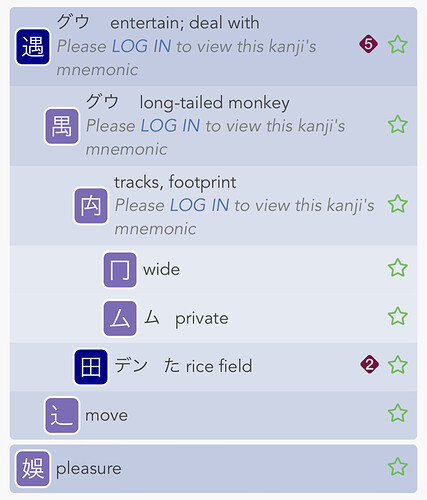My advice would be - don’t use RTK. 
I started out learning kanji with RTK. I bought into the basic premise of learning to write first - and within 6 months I had learned over a 1,000 kanji - printing them and one meaning keyword. Then I burned out.
A major problem with the approach, as I see it, is that it frontloads the process with learning meaning and printing them. It leaves a major stumbling point for later: the sounds.
First of all, climbing “the whole mountain” before you get to the sounds can be terribly frustrating at some point because it’s easy to lose sight of the goal - learning Japanese, not kanji.
Then, the topic of sounds is almost bigger than the kanji themselves and having looked at RTK2 I think it’s didactically horrible. The further you get in the RTK course, the lazier it gets, leaving all the work to you and merely providing structure. It gets so sparse, it’s - to me - not really helpful.
Coming up with mnemonics of your own can be a good way to internalize them, but once you are challenged to do that for 80% or more of them (because the course no longer does), you have a lot of work cut out to you. That nobody (slight hyperbole) likes to do that is clear from the many Anki decks out there doing it for you.
Next thing: There are several Anki decks out there for RTK and they save you a lot of time and work. But there is time and time again stuff in them that you wish you wouldn’t have exposed your brain to. Same goes for Kanji Damage… If the mnemonic sticks, all the worse. You’re going to look at the basic kanji a lot in the future, so I don’t want bad associations I need to “unlearn” later…
After “learning” to write 1,000 kanji and associate meaning from RTK + Anki, I changed to Wanikani. It took a while until I met some of them again. Retention of kanji was negligible! I had written some of them a hundred times, I did an hour of kanji writing each day towards the end, and yet when I encountered them again after stopping, I more often than not learned them anew.
Also, some 800 or so in, I couldn’t shake the feeling (with RTK), that I’m not learning Japanese. I could “meaning-read” parts of sentences, but that quickly lost its shine as without being able to connect it to sounds and vocab, it does surprisingly little (at least for me) for learning to understand the language unless you sit through all of it. That’s what I meant when I said I “burned out” on it - I was seriously questioning my choices and if I felt I was making progress towards my actual goal.
Having said all that, I’m not entirely sure about it, but I think RTK2 misses out on Kei-Sei (semantic-phonetic grouping) of kanji. The majority of kanji, some say numbers like 68%, are not made up so that they mirror meaning but they mirror sound (at least more than meaning). A kanji belonging to the Kei Sei group will be composed of at least two more primitive kanji (or their simplified radical form). One will imply a broad category of meaning (like for example finger having to do with actions done with the hands) and another will be there not for its meaning, but for its sound.
Apparently this thing is even more common and evident in Chinese, but Japanese is a Troy of past languages (layer upon layer) - retaining and grouping sounds from the original Japanese language and multiple dominant Chinese dialects (Japanese-pronounced), so a fair share of Kei Sei have been overwritten or sound-shifted over time. Still, Kei Sei is a fantastic tool for looking at whole groups of kanji and retaining their sounds.
Having said that, Wanikani has extension scripts (by users) that tap into a big DB of Kei Sei goodness that I haven’t found elsewhere and that I find vital for retaining sounds easily. Any resource for learning Japanese should as well, unless you want to needlessly tie sounds to kanji over and over again.
I’m a fan of Wanikani besides its flaws. If you don’t mind going by their pace and order, it’s a great tool. They put a lot of work into their mnemonics, and users added the rest with scripts.
I find that with Wanikani I learned a lot of basic vocab that I retain well. For any kanji I can typically immediately recall its most common sound, whether on or kun and/or one basic meaning, and for many all of that or even rare meanings. I found this much more useful than being able to print them. And considerably less time-consuming!!
I think the retention is higher with any course teaching kanji in context with sounds as your brain ties to them multiple times. Kanji with kun sound. Kanji meaning with mnemonic to help you along. Kanji with on sound. Kanji with another on sound. Vocab 1 using kanji this way, vocab 2 using kanji that way. You will always retain some of that in the least and can work your way back to that.


